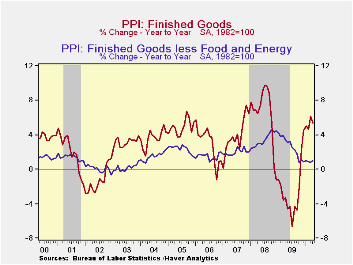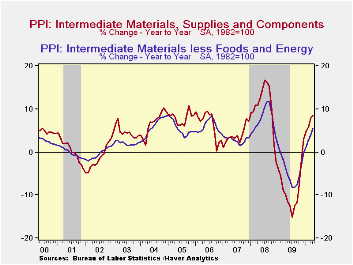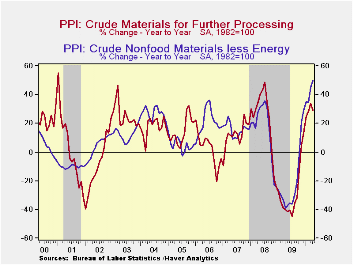 Global| May 18 2010
Global| May 18 2010U.S. PPI Slips With Lower Food & Energy Prices
by:Tom Moeller
|in:Economy in Brief
Summary
Thanks to lower food & energy prices, the overall producer price index fell 0.1% last month (+5.4% y/y) following a 0.7% March increase. Consensus expectations had been for a 0.1% uptick. Nevertheless, the y/y gain in prices of 5.4% [...]

Thanks to lower food & energy prices, the overall producer price index fell 0.1% last month (+5.4% y/y) following a 0.7% March increase. Consensus expectations had been for a 0.1% uptick. Nevertheless, the y/y gain in prices of 5.4% remained near the higlyhest since late-2008.
Finished energy prices fell 0.8% (+20.6% y/y) and reversed all of the March gain. A moderate gain in not seasonally adjusted monthly gasoline prices (52.7% y/y) was the third this year and home heating oil prices rose about as they did in March (48.5% y/y). Finally, natural gas prices continued lower (-2.5% y/y) but electricity prices rose (1.6% y/y).
A 0.2% slip (+4.9% y/y) in finished food prices last month followed the 2.4% March jump. The decline was greatest amongst fresh fruit (+17.3% y/y), vegetable (33.3% y/y) and egg prices (-20.8% y/y). Beef prices (16.0% y/y) were strong for the third straight month.
The 0.2% increase in finished producer prices less food & energy prices was the firmest since January and beat Consensus expectations for a 0.1% uptick. Nevertheless, the 1.0% y/y increase remained nearly the weakest since early-2004. Continuing to lose steam was the PPI for finished consumer goods less food & energy. It rose 0.2% and left the 1.5% y/y increase half the annual gains during the last two years. Finished durables prices ticked up 0.1% (0.4% y/y) while core finished consumer nondurable goods prices gained a modest 0.2% (2.4% y/y), nearly the weakest rise since early 2007. Capital equipment prices rose 0.2% (0.3% y/y) versus annual gains between 1.0% and 3.0% back to 2004.
Future pressure on finished goods prices may possibly stem from higher prices for intermediate goods. Their 0.8% increase raised the y/y gain to 8.5%. Core prices jumped 1.1% and the 5.6% y/y gain was the strongest since late-2008. The strength reflected increases in the price of copper & mill shapes, steel & aluminum.
Additional price pressure to come also may be evident in the 4.0% increase (49.7 y/y) in core crude materials producer prices. The jump was led by higher scrap copper prices which have nearly doubled and iron & steel scrap prices which have more than doubled.
The producer price data is available in Haver's USECON database. More detailed data is in the PPI and in the PPIR databases.


| Producer Price Index(%) | April | March | February | y/y | 2009 | 2008 | 2007 |
|---|---|---|---|---|---|---|---|
| Finished Goods | -0.1 | 0.7 | -0.6 | 5.4 | -2.5 | 6.4 | 3.9 |
| Less Food & Energy | 0.2 | 0.1 | 0.1 | 1.0 | 2.6 | 3.4 | 2.0 |
| Intermediate Goods | 0.8 | 0.6 | 0.1 | 8.5 | -8.4 | 10.3 | 4.0 |
| Less Food & Energy | 1.1 | 0.7 | 0.9 | 5.6 | -4.2 | 7.4 | 2.8 |
| Crude Goods | -1.2 | 3.2 | -3.5 | 28.9 | -30.4 | 21.4 | 11.9 |
| Less Food & Energy | 4.0 | 6.0 | -0.6 | 49.7 | -23.5 | 14.8 | 15.6 |
Tom Moeller
AuthorMore in Author Profile »Prior to joining Haver Analytics in 2000, Mr. Moeller worked as the Economist at Chancellor Capital Management from 1985 to 1999. There, he developed comprehensive economic forecasts and interpreted economic data for equity and fixed income portfolio managers. Also at Chancellor, Mr. Moeller worked as an equity analyst and was responsible for researching and rating companies in the economically sensitive automobile and housing industries for investment in Chancellor’s equity portfolio. Prior to joining Chancellor, Mr. Moeller was an Economist at Citibank from 1979 to 1984. He also analyzed pricing behavior in the metals industry for the Council on Wage and Price Stability in Washington, D.C. In 1999, Mr. Moeller received the award for most accurate forecast from the Forecasters' Club of New York. From 1990 to 1992 he was President of the New York Association for Business Economists. Mr. Moeller earned an M.B.A. in Finance from Fordham University, where he graduated in 1987. He holds a Bachelor of Arts in Economics from George Washington University.






